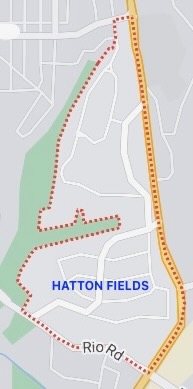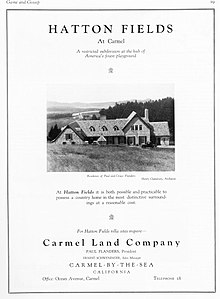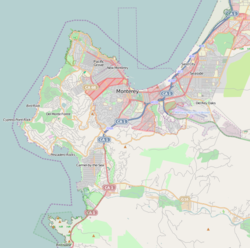Hatton Fields | |
|---|---|
 Hatton Fields in 1921 | |
| Coordinates: 36°32′36″N 121°54′42″W / 36.54333°N 121.91167°W | |
| Country | United States |
| State | California |
| County | Monterey County |
| Elevation | 125 ft (38 m) [1] ft (38m m) |
| Time zone | UTC-8 ( PST) |
| • Summer ( DST) | UTC-7 ( PDT) |
Hatton Fields is an unincorporated community southeast of downtown Carmel-by-the-Sea in Monterey County, California, United States. Homes have views of Carmel Valley, Point Lobos, and Carmel Bay. The residential neighborhood is bordered by Rio Road to the south, Hatton Road to the north, Hatton Canyon to the east, and Junipero Street to the west. The terrain is rolling and naturally landscaped with mature oaks, redwoods, and Monterey Pine trees. Carmel High School, Carmel Mission, and Flanders Mansion are landmarks in this neighborhood. Carmel Mission and Flanders Mansion are two properties that are listed on the National Register of Historic Places. The Mission Trail Nature Preserve runs adjacent to Hatton Fields. Homes are part of the Carmel Unified School District.
History
William Hatton (1849–1894), born in Ireland and married to Kate Harney (1851-1922), came to California in 1870. In 1888, Hatton became the manager of Rancho Cañada de la Segunda, which extended along the north bank of the Carmel River into the mouth of Carmel Valley. The land was owned by Dominga Doni de Atherton, the widowed wife of Faxon Atherton (namesake of Atherton, California). By 1892, Hatton purchased the Rancho from Dominga. Hatton operated a dairy business, which was located at Highway 1 and Carmel Valley Road, at the site of the present-day The Barnyard Shopping Village. [2] When Hatton died in 1894, the land was left to his heirs. Anna, who was married to William Martin was given the area known as Martin Ranch (now Mission Ranch), Harrieta was given the area known as Rio Vista. Sarah was given the area known as Mission Fields. William Jr., received the area now east of Rio Vista, and Edward became owner of what became known as Hatton Fields. [3] In 1921, the Hatton Fields was still being used for grazing cattle from the Hatton dairy. [4]
William Hatton gave his name to Hatton Fields and to Hatton Canyon at Carmel Valley Road via a dirt trail at the mouth of Carmel Valley. [5]
Paul and Grace Flanders moved to Carmel in 1923, to construct a home and begin a real estate business. They purchased 80 acres (32 ha) of land from Dr. Daniel T. MacDougal, of the botanical laboratory for the Carnegie Institution in Carmel-by-the-Sea, California. Flanders designed a two-story home, which they named the Outlands in the Eighty Acres or Outlands at 25800 Hatton Road, located on a hill facing the Carmel Mission, and Point Lobos. Light grey interlocking Thermotite blocks, produced by the Carmel Thermotite Company, were used to build the home. Flanders planned on using his home as a model for a subdivision he planned to develop. [6] [7]

In 1925, Paul Flanders founded the Carmel Land Company to help develop Hatton Fields. He purchased 233.15 acres (94.35 ha) of property from the Hatton estate for $100,000 (equivalent to $1,737,381 in 2023). The new company formed an office in a stucco building on Ocean Avenue between Louis S. Slevin's general merchandise store and the Carmel Bakery. Paul Flanders was president, Ernest Schweninger was secretary and sales manager, and Peter Mawdsley was the treasurer. [8] [9] Hatton Fields was one of three major land developments adjacent to the Carmel city limits between 1922 and 1925. The other two were Carmel Woods, a 125 acres (51 ha) tract on the north side, and the Walker Tract to the south, which was 216 acres (87 ha) of the Martin Ranch called The Point. [10]
One of the largest and most important realty deals ever consummated in this vicinity took place last week when the probate court at Salinas confirmed the sale of 233 acres of land belonging to the Hatton estate. The purchasers of this splendid tract of land east of the Carmel city limits is a group of capitalists headed by Paul Flanders, who recently completed a beautiful residence in the vicinity of the property...The land involved in the deal is bounded at its northern point by Second Avenue in Carmel; on the west by the city limits; on the south by the county road that runs in front of the Carmel Mission and on the east by the same road...Henry H. Gutterson, landscape engineer for Mason McDuffie company of San Francisco,...has been retained to act as supervising architect in the laying out of the homesites and streets on the local tract.
— Carmel Pine Cone
June 27, 1925 [11]

There were 99 building sites in the first tract with lots that ranged in size from .333 acres (0.135 ha)an acre to 3 acres (1.2 ha). The first to purchase land at Hatton Fields was director Perry Newberry. He said, "We are glad to live in Hatton Fields because we find there the seclusion that is no longer obtainable at a moderate price in Carmel property." Stockholders in the Carmel Land Company were Flanders, Schweninger, Harry Leon Wilson, Charles King Van Riper, Fred Ruhl, and Carmel Martin. Initial sales went well. [12] [13]
On August 4, 1939, the company sold 22 miles (35 km) of the Hatton property for $31,000 (equivalent to $679,033 in 2023) for the Carmel High School. The school opened on September 6, 1940. [14]
The Abalone League had its beginning on Carmel Point in 1921. They played two games on Sunday and had three playing fields, at Carmel Point, Carmel Woods, and the Hatton Fields. [3]
In January 1947, the Carmel Land Company was sold to Charles A. Fuller's Carmel Company for $150,000 (equivalent to $2,046,796 in 2023). Schweninger continued as sales manager with the new company. [13] Included in the sale were all the unsold portions of Hatton Fields tract consisting of 40-50 lots. Fuller was resident of Carmel for over 20 years. Fuller wanted to open the tract for development. [15] [3] [16]
See also
- National Register of Historic Places listings in Monterey County, California
- List of places in California
- Timeline of Carmel-by-the-Sea, California
References
- ^ "Elevation of Hatton Fields, Carmel-By-The-Sea, CA, USA". elevation.maplogs.com. Hatton Fields. Retrieved October 19, 2022.
-
^ Barratt, Elizabeth (2009).
Carmel Valley. Arcadia. pp. 44–45.
ISBN
9780738571621. Retrieved October 18, 2022.
{{ cite book}}:|work=ignored ( help) - ^ a b c Hale, Sharron Lee (1941). A Tribute to Yesterday: The history of Carmel, Carmel Valley, Big Sur, Point Lobos, Carmelite Monastery, and Los Burros. Santa Cruz, Calif.: Valley Publishers. pp. 59, 48. ISBN 9780913548738. Retrieved July 17, 2022.
-
^ Hudson, Monica (May 24, 2006).
Carmel-by-the-Sea. Arcadia.
ISBN
9781439614570. Retrieved October 18, 2022.
{{ cite book}}:|work=ignored ( help) - ^ Jack Jarnegan (December 1974). "NOTICIAS del PUERTO de MONTEREY" (PDF). Monterey History and Art Association. 18 (4). Monterey, California. Retrieved February 8, 2023.
- ^ Seavey, Kent L. (August 1988). "National Register of Historic Places Registration Form: Outlands in the Eighty Acres". National Park Service. Retrieved February 5, 2022.
- ^ "Easter Brings Eastbay Folk to Art Colony". Oakland Tribune. Oakland, California. April 12, 1925. p. 21. Retrieved February 5, 2022.
- ^ "How the high school got there" (PDF). Carmel Pine Cone. Carmel, California. November 26, 2021. p. 22. Retrieved November 26, 2021.
- ^ "Property Transactions". Carmel Pine Cone. Carmel-by-the-Sea, California. December 12, 1925. p. 12. Retrieved October 18, 2022.
- ^ "Outlands In The Eighty Acres". United States Department of Interior National Park Service. February 21, 1989. Retrieved October 18, 2022.
- ^ "Hatton Land Sold for Residence Sites". Carmel Pine Cone. Carmel-by-the-Sea, California. June 27, 1925. p. 1. Retrieved October 18, 2022.
- ^ "Hatton Fields". Carmel Pine Cone. Carmel-by-the-Sea, California. February 6, 1926. p. 1. Retrieved October 18, 2022.
- ^ a b Neal Hotelling (July 2, 2021). "Baking bread and playing roles" (PDF). Carmel Pine Cone. Carmel-by-the-Sea, California. pp. 23, 27. Retrieved October 14, 2022.
- ^ "Site For School". The Californian. Salinas, California. August 4, 1939. p. 5. Retrieved November 26, 2021.
- ^ "Lat Undeveloped Carmel Tract Is Sold in Big Deal". Carmel Pine Cone. Carmel-by-the-Sea, California. January 3, 1947. p. 1. Retrieved October 19, 2022.
- ^ "Coast Area News Roundup". The Californian. Salinas, California. January 6, 1947. p. 3. Retrieved October 19, 2022.

